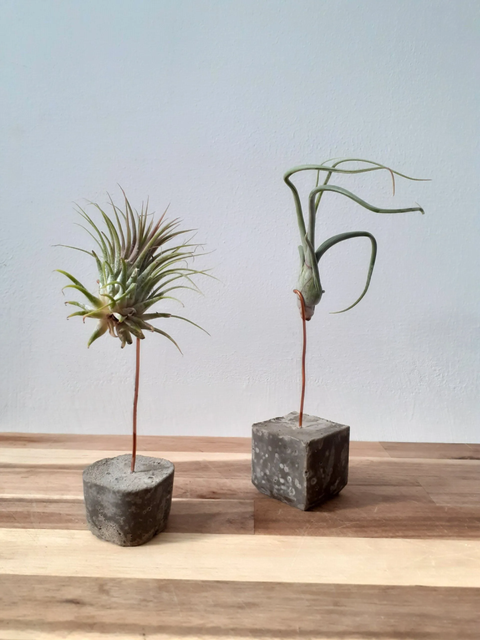Description: Airplants (Tillandsia spp.) are from Mexico and South America. They are so-named because they use their short, wiry roots to attach themselves to branches, cliff-faces, even electricity and telephone lines, rather than rooting in soil.
Cultivation: The most important considerations when cultivating airplants are their requirements for air, light, water and warmth. Plants can be placed outside in the summer in the UK to benefit from the brighter conditions, rainfall and increased humidity. Return them under glass or bring indoors in early autumn.
Tillandsia have leaves coated in specialised water-absorbent cells called trichomes which in some species are so dense they give the plants a silvery, frosted appearance. The trichomes are their primary method of obtaining moisture from rainfall or fog.
Airplants are often grown on gnarled wood, or shells and rocks to which they are glued for support. The ornamental appearance of Tillandsia and their colourful, exotic-looking flowers make them intriguing and popular plants to grow in the home and conservatories.
Ventilation: Airplants have evolved in sites which all have superior airflow. It is therefore very important to provide a well-ventilated position for plants to remain healthy.
Light levels: Tillandsia enjoy bright but diffused light, so provide light shade from direct sunshine, particularly under glass. A position in a south-facing window behind a net curtain is ideal.
Watering and feeding
- From spring until autumn, immerse plants in rainwater on average two to three times a week, allowing them to dry off in between
- Avoid using tapwater especially in hard water areas as the water contains dissolved sodium bicarbonate which can precipitate out on the trichomes and block them, preventing the Tillandsia from absorbing moisture and nutrients
- In higher temperatures and low atmospheric humidity, watering may be required more frequently; less often in cooler, humid conditions
- Misting plants in-between immersing them can help to prevent dehydration in warm conditions, but does not provide sufficient moisture alone so should not be used instead of immersion
- Avoid watering plants if temperatures drop to 12ºC (54ºF) as they can remain wet for too long
- In summer, plants can occasionally be left to soak overnight in water to which some fertiliser suitable for orchids has been added. This will ensure they are fully hydrated and able to absorb the fertiliser. Tillandsia will not tolerate being kept in water for longer periods or being kept continuously wet
- Allowing plants to dry off in between watering is very important for good plant health
- Plants should be angled facing downwards when mounted, to allow water to drain out of the centre or crown of the plant, or gently shaken after watering to dislodge any water droplets
Temperature: Plants do best if the temperature does not drop below 12°C (54°F) and can tolerate a maximum of 30°C (86°F) if relative humidity is high.
Pruning: Most bromeliads including Tillandsia are monocarpic, meaning they grow to maturity, flower, set seed and then die, but not before producing offsets or young plants from the base. The mother plant once it has died completely, can be pruned away, leaving the offsets in situ to grow on; but pruning is not otherwise required.
Information taken from RHS Gardening

